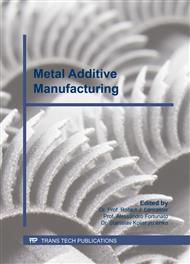p.1565
p.1570
p.1574
p.1579
p.1585
p.1591
p.1597
p.1603
p.1607
The Influence of Powder Particle and Grain Size on Parts Manufacturing by Powder Bed Fusion
Abstract:
Nanostructured powder materials, or powders with increased amorphous ratio, can potentially lead to increased productivity during powder bed fusion, due to the hypothesis that nanostructured raw materials can be layer-sintered with lower specific energy, and consequently lower processing times when compared to commercial powders. Sintering of such materials can potentially be done faster, as compared to conventional powders. In addition, using nanostructured powders, or powders with high amorphous content, or even nanometric (nanosized particles) powders, can result in higher density and hardness values of the sintered part, using the same process parameters. The main issue with nanosized particles is their loss of flowability, which could be overcome by controlling the particle shape during manufacturing. This work presents our results concerning the manufacturing and characterization of titanium alloy powders, with potential use in additive manufacturing. The powders were manufactured using severe plastic deformation by mechanical milling from commercially available powders, with various rotation speeds, ball diameters, and milling periods, in order to obtain micrometric particles, but with nanometric or high amorphous content structures. The powders were further analyzed in terms of morphology, structure, and chemical composition.
Info:
Periodical:
Pages:
1585-1590
Citation:
Online since:
December 2018
Price:
Сopyright:
© 2018 Trans Tech Publications Ltd. All Rights Reserved
Share:
Citation:



